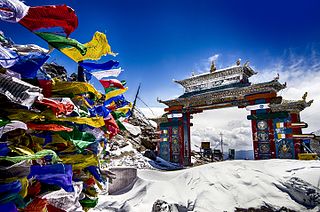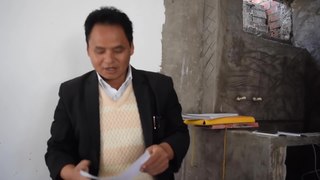Related Research Articles

Manipur is a state in northeast India, with the city of Imphal as its capital. It is bounded by the Indian states of Nagaland to the north, Mizoram to the south and Assam to the west. It also borders two regions of Myanmar, Sagaing Region to the east and Chin State to the south. The state covers an area of 22,327 km2 (8,621 sq mi). The official and most widely spoken language is the Meitei language. Native to the Meitei people, it is also used as a lingua franca by smaller communities, who speak a variety of other Tibeto-Burman languages. Manipur has been at the crossroads of Asian economic and cultural exchange for more than 2,500 years. This exchange connects the Indian subcontinent and Central Asia to Southeast Asia, East Asia, Siberia, regions in the Arctic, Micronesia and Polynesia enabling migration of people, cultures and religions.

The Munda languages are a group of closely related languages spoken by about nine million people in India, Bangladesh and Nepal. Historically, they have been called the Kolarian languages. They constitute a branch of the Austroasiatic language family, which means they are more distantly related to languages such as the Mon and Khmer languages, to Vietnamese, as well as to minority languages in Thailand and Laos and the minority Mangic languages of South China. Bhumij, Ho, Mundari, and Santali are notable Munda languages.

Meitei, also known as Manipuri, is a Tibeto-Burman language of northeast India. It is the official language and the lingua franca of Manipur and one of the official languages of Assam. It is one of the constitutionally scheduled official languages of the Indian Republic. Meitei is the most widely-spoken Tibeto-Burman language of India and third most widely spoken language of northeast India after Assamese and Bengali. There are 1.76 million Meitei native speakers in India according to the 2011 census. Most of these, or 1.52 million, are found in the state of Manipur, where they represent majority of its population. There are smaller communities in neighbouring Indian states, such as Assam (168,000), Tripura (24,000), Nagaland (9,500), and elsewhere in the country (37,500). The language is also spoken by smaller groups in neighbouring Myanmar and Bangladesh.

Northeast India, officially the North Eastern Region (NER), is the easternmost region of India representing both a geographic and political administrative division of the country. It comprises eight states—Arunachal Pradesh, Assam, Manipur, Meghalaya, Mizoram, Nagaland and Tripura, and the "brother" state of Sikkim.

The Meitei people, Meetei, Manipuri people is an ethnic group native to Manipur. They form the largest and dominant ethnic group of Manipur in Northeast India. They speak the Meitei language, one of the 22 official languages of the Indian Republic and the sole official language of Government of Manipur. The Meiteis primarily settled in the Imphal Valley region in modern-day Manipur, though a sizeable population has settled in the other Indian states of Assam, Tripura, Nagaland, Meghalaya, and Mizoram. There is also a notable presence of Meitei people in the neighbouring countries of Myanmar and Bangladesh. The Meitei ethnic group represents about 53% of Manipur's population.

The Tangshang people or Tangsa Naga, are of Tibeto-Burmese ethnic group of the Arunachal Pradesh and Assam. They also reside in Sagaing Region and parts of Kachin State of Myanmar. In Myanmar they were formerly known as Rangpang, Pangmi, and Haimi. They speak their own language Tangsa.
Tshangla is a Sino-Tibetan language of the Bodish branch closely related to the Tibetic languages. Tshangla is primarily spoken in Eastern Bhutan and acts as a lingua franca in the region; it is also spoken in the adjoining Tawang tract in the Indian state of Arunachal Pradesh and the Pemako region of Tibet. Tshangla is the principal pre-Tibetan language of Bhutan.
The Kiranti languages are a major family of Sino-Tibetan languages spoken in Nepal and India by the Kirati people.
The Tangkhulic and Tangkhul languages are a group of Sino-Tibetan languages spoken mostly in northeastern Manipur, India. Conventionally classified as "Naga," they are not clearly related to other Naga languages, and are conservatively classified as an independent Tangkhul–Maring branch of Tibeto-Burman, pending further research.
The Kuki-Chin languages are a branch of the Sino-Tibetan language family spoken in northeastern India, western Myanmar and southeastern Bangladesh. Most notable Kuki-Chin-speaking ethnic groups are referred to collectively as the Zo people which includes: the Mizo of Mizoram, the Kuki of Manipur, and the Chin of Chin State, Myanmar.

The Idu Mishmi language is a small language spoken by the Mishmi people in Dibang Valley district, Lower Dibang Valley district, Lohit district, East Siang district, Upper Siang district of the Indian state of Arunachal Pradesh and in Zayü County of the Tibet Autonomous Region, China. There were 8569 speakers in India in 1981 and 7000 speakers in China in 1994. It is considered an endangered language.

The Eastern Indo-Aryan languages, also known as Māgadhan languages, are spoken throughout the eastern region of the subcontinent, which includes Bihar, Uttar Pradesh, Jharkhand, Bengal region, Tripura, Assam, and Odisha; alongside other regions surrounding the northeastern Himalayan corridor. Bengali is official language of Bangladesh and the state of West Bengal, Tripura and the Barak valley of Assam while Assamese and Odia are the official languages of Assam and Odisha, respectively. The Eastern Indo-Aryan languages descend from Abahattha, which descends from Magadhan Apabhraṃśa and ultimately from Magadhi Prakrit.

Tangsa, also known as Tase and Tase Naga, is a Sino-Tibetan language or language cluster spoken by the Tangsa people of Burma and north-eastern India. Some varieties, such as Shangge (Shanke), are likely distinct languages. There are about 60,000 speakers in Burma and 40,000 speakers in India. The dialects of Tangsa have disparate levels of lexical similarity, ranging from 35%–97%.

Maring and Uipo are closely related Sino-Tibetan languages spoken by the Maring and Khoibu people in Manipur, India. Linguistically, they are closest to the Tangkhulic languages.
Magar Kaike is a Sino-Tibetan language of Nepal. Ethnologue classifies it as a West Bodish language.
Thakali is a Sino-Tibetan language of Nepal spoken by the Thakali people, mainly in the Myagdi and Mustang Districts. Its dialects have limited mutual intelligibility.

The Cinema of Manipur is the film industry based in Manipur, India. It includes not only Meitei language movies but all the films made in different languages of the different communities in Manipur. The Manipuri film industry was born when Matamgi Manipur by Debkumar Bose was released on 9 April 1972. From Aribam Syam Sharma's Paokhum Ama, the first colour Manipuri film (1983), M.A Singh's Langlen Thadoi, the first full-length colour Manipuri film (1984), Oken Amakcham's Lammei, the first Manipuri digital film (2002), to Priyakanta Laishram's Oneness (film), the first Manipuri gay-themed film (2023), Manipuri cinema, which celebrated its 50th anniversary in 2022, has grown in both its form and culture.
Suansu is a Tangkhulic language of Manipur, India, first reported in 2019. It is spoken by approximately 2,000 people in several villages of Ukhrul District, Manipur.
Proto-Hmongic or Proto-Miao is the reconstructed ancestor of the Hmongic languages.
Kongai is a Tangkhulic language of Ukhrul District, Manipur, India.
References
- ↑ Ivani, Jessica K. (under review) Some preliminary notes on Challow, a Tibeto-Burman language from Manipur, India.
- ↑ IVANI, Jessica K & ZAKHARKO, Taras. 2023. Linguistic diversity in North-East India: a comparative look at neighboring languages Suansu, Kongai and Challow. 26th Himalayan Languages Symposium, 4-6 September 2023. Paris: INALCO.
- ↑ IVANI, Jessica K. 2023. Challow language from northeastern India: a field report. 26th Himalayan Languages Symposium, 4-6 September 2023. Paris: INALCO.
